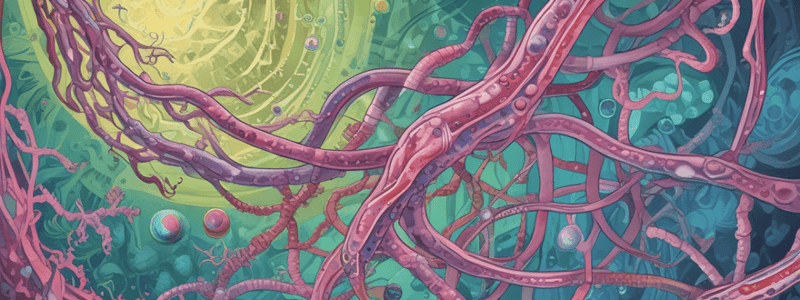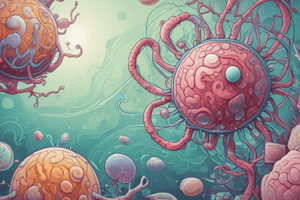Podcast
Questions and Answers
What is the primary function of the cell wall in bacterial cells?
What is the primary function of the cell wall in bacterial cells?
- To regulate gene expression
- To synthesize proteins
- To facilitate cell movement
- To provide structural support and maintain cell shape (correct)
Which of the following is NOT a characteristic of peptidoglycan?
Which of the following is NOT a characteristic of peptidoglycan?
- It is a polymer composed of hexose sugars and amino acids
- It is found in the cell walls of both Gram-positive and Gram-negative bacteria
- It provides structural support to the bacterial cell
- It is a component of the bacterial plasma membrane (correct)
What is the main difference between Gram-positive and Gram-negative bacteria?
What is the main difference between Gram-positive and Gram-negative bacteria?
- The ability to form spores
- The type of flagella present
- The presence or absence of a cell wall
- The composition of the cell wall peptidoglycan layer (correct)
Which of the following is an example of an opportunistic fungal infection?
Which of the following is an example of an opportunistic fungal infection?
What is the function of the capsule in bacterial cells?
What is the function of the capsule in bacterial cells?
What is the primary function of the flagella in bacterial cells?
What is the primary function of the flagella in bacterial cells?
Which of the following is NOT a component of a bacterial cell?
Which of the following is NOT a component of a bacterial cell?
What is the function of the plasmid in bacterial cells?
What is the function of the plasmid in bacterial cells?
What is the minimum number of subunits in an icosahedral capsid?
What is the minimum number of subunits in an icosahedral capsid?
Which type of viral symmetry is characterized by capsomeres bound in a periodic fashion to the viral genome, winding the genome into a helix?
Which type of viral symmetry is characterized by capsomeres bound in a periodic fashion to the viral genome, winding the genome into a helix?
What is the function of the viral matrix protein in the viral envelope?
What is the function of the viral matrix protein in the viral envelope?
Which of the following viruses has a complex capsid?
Which of the following viruses has a complex capsid?
What is the function of viral surface proteins?
What is the function of viral surface proteins?
Which type of virus is stable in the environment and may be transmitted by food or water?
Which type of virus is stable in the environment and may be transmitted by food or water?
What is the viral genome enclosed by?
What is the viral genome enclosed by?
What is the term for the continuous cylinder surrounded by a lipid layer and complex proteinaceous core wall in poxviruses?
What is the term for the continuous cylinder surrounded by a lipid layer and complex proteinaceous core wall in poxviruses?
Which of the following types of genomes typically encodes its own RNA-dependent RNA polymerase?
Which of the following types of genomes typically encodes its own RNA-dependent RNA polymerase?
What is the primary function of reverse transcriptase in retroviruses?
What is the primary function of reverse transcriptase in retroviruses?
What is the characteristic of the infectious agent responsible for prion diseases?
What is the characteristic of the infectious agent responsible for prion diseases?
Which of the following diseases is NOT a parasitic infection?
Which of the following diseases is NOT a parasitic infection?
What is a characteristic of Schistosomiasis?
What is a characteristic of Schistosomiasis?
Which of the following statements about Toxoplasmosis is TRUE?
Which of the following statements about Toxoplasmosis is TRUE?
What is the primary function of the thick keratin-like coat of a bacterial spore?
What is the primary function of the thick keratin-like coat of a bacterial spore?
Which of the following is a characteristic of viral genomes?
Which of the following is a characteristic of viral genomes?
What is the primary function of the capsid protein in a virus?
What is the primary function of the capsid protein in a virus?
Which of the following is a characteristic of bacterial spores?
Which of the following is a characteristic of bacterial spores?
What is the term for the process of killing bacterial spores using high pressure and heat?
What is the term for the process of killing bacterial spores using high pressure and heat?
What is the primary function of the viral polymerase protein?
What is the primary function of the viral polymerase protein?
What is the term for the protein subunits that make up the capsid of a virus?
What is the term for the protein subunits that make up the capsid of a virus?
What is the primary function of the host cell machinery during viral replication?
What is the primary function of the host cell machinery during viral replication?
Which of the following characteristics is NOT used for bacterial classification?
Which of the following characteristics is NOT used for bacterial classification?
What is the primary way in which bacterial growth is affected?
What is the primary way in which bacterial growth is affected?
Which of the following bacteria is classified as Gram Positive?
Which of the following bacteria is classified as Gram Positive?
What is the primary difference between obligate aerobes and facultative anaerobes?
What is the primary difference between obligate aerobes and facultative anaerobes?
Which of the following is an example of a biochemical property used for bacterial classification?
Which of the following is an example of a biochemical property used for bacterial classification?
What is a more recent method used for bacterial classification?
What is a more recent method used for bacterial classification?
Which of the following bacteria is an example of an acid-fast stain?
Which of the following bacteria is an example of an acid-fast stain?
Which of the following is NOT a type of bacteria that infects humans?
Which of the following is NOT a type of bacteria that infects humans?
Study Notes
Characteristics of Bacteria
- Morphological characteristics used for classification:
- Nature of the cell wall
- Staining (e.g., Gram stain)
- Shape (e.g., cocci, bacilli/rods, spirilla/spirochetes)
- Spore-forming abilities
- Biochemical properties:
- Metabolism (e.g., obligate aerobes, facultative anaerobes, obligate anaerobes)
- Production of specific enzymes (e.g., coagulase) or toxins (e.g., hemolysins)
- DNA sequencing of their genome
Examples of Bacteria Infecting Humans
- Gram-positive bacteria:
- Cocci (e.g., Staphylococcus aureus)
- Rods (Bacilli) (e.g., Bacillus subtilis)
- Gram-negative bacteria:
- Cocci (e.g., Neisseria gonorrhoeae)
- Rods (Bacilli) (e.g., Pseudomonas aeruginosa)
- Miscellaneous/poorly staining bacteria:
- Intracellular bacteria (e.g., Chlamydia)
- Acid-fast stain bacteria (e.g., Mycobacterium tuberculosis)
- Mycoplasma
- Opportunistic bacteria (e.g., Pseudomonas aeruginosa)
- Examples of bacterial infections:
- Cryptococcosis (Cryptococcus spp.)
- Candidiasis (Candida spp.)
- Aspergillosis (Aspergillus spp.)
- Pneumocystis pneumonia (Pneumocystis spp.)
- Ringworm (e.g., Microsporum spp.)
- Athlete’s foot (Trichophyton spp.)
General Properties of Bacteria
- Components of a bacterial cell:
- Essential components:
- Cell wall
- Plasma membrane
- Ribosome
- Nucleoid
- Non-essential components:
- Capsule
- Flagella
- Pili (Fimbriae)
- Plasmid
- Spore
- Essential components:
- Structure of bacteria:
- Cell wall: multilayered structure mainly composed of peptidoglycan
- Peptidoglycan: polymer composed of hexose sugars (N-acetylglucosamine and N-acetylmuramic acid) and amino acids
- Gram stain: classification based on cell wall characteristics
- Spores: highly resistant structures formed in response to adverse conditions
General Properties of Viruses
- Distinguishing characteristics:
- Intracellular parasites
- Contain either DNA or RNA genomes (never both)
- Novel genetic material encoding structural and functional proteins
- Basic virus structure:
- Essential components:
- Genome (DNA or RNA)
- Capsid
- Polymerase protein
- Non-essential components:
- Envelope
- Envelope protein
- Essential components:
- Structure of viruses:
- Capsid: constructed from virally-encoded protein subunits (capsomeres)
- Viral genome: enclosed by the capsid protein coat
- Symmetry: icosahedral, helical, or complex
Importance of Viral Surface Proteins
- Attach to membrane proteins (Receptors) in host cell: determinants of tropism
- RNA genomes:
- Most examples encode their own RNA-dependent RNA polymerase
- Retroviruses (and hepadna-): use reverse transcriptase to copy a +ve ssRNA genome into dsDNA
Additional Information
- Prion (PRoteinaceous Infectious particle) Diseases:
- Group of fatal and infectious neurodegenerative diseases
- Infectious agent propagates in the absence of nucleic acid
- Infectious agent is a misfolded protein that alters folding of the normal host version of the protein
- Examples of parasitic diseases:
- Taenia solium (pork tapeworm)
- Schistosomiasis
- Malaria
- Toxoplasmosis
- Leishmaniasis
Studying That Suits You
Use AI to generate personalized quizzes and flashcards to suit your learning preferences.
Description
This quiz covers the characteristics of bacteria used for classification, including morphological and biochemical properties. Learn about the importance of cell walls, staining, shape, spore-forming abilities, and metabolic processes in identifying bacteria.



